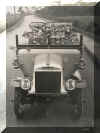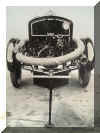 This is a
1929 Hall Lewis C25R bodied Leyland TS2
(see the Hall
Lewis page for more information).
This is a
1929 Hall Lewis C25R bodied Leyland TS2
(see the Hall
Lewis page for more information).The British Leyland Motor Corporation could date its heritage back to 1896, when the Sumner and Spurrier families founded the Lancashire Steam Motor Company at Leyland eventually being renamed Leyland Motors as far back as 1907.
In 1962 the ACV Group was merged with the newly formed Leyland Motor Corporation and in 1968 this business was once again renamed as the British Leyland Motor Corporation by the merger of Leyland and British Motor Holdings; the latter being an amalgamation of Austin, Morris and the Jaguar-Daimler-Guy group.
Leyland had, at its peak, a vast number of manufacturing plants and an extremely diverse product list. Its many merged companies, that were previous rivals, were allowed to continue with similar, in fact virtually identical, products, competing in the same marketplace across which there was considerable replication. British Leyland (or BL as it was known) found itself unable to manage the huge and complex variety of businesses and its failure to "rightsize" (no doubt partially due to the potential for industrial action) eventually forced it into bankruptcy in 1975 when it was effectively nationalised by the then Labour Government. Its following history was one of closures, the shedding of assets and ironically the loss of employment that might have otherwise been saved by the lost opportunity of appropriate streamlining.
In 1986 Leyland Trucks & Vans was bought buy the Dutch firm DAF which in 1993 sold off what was left. The US conglomerate PACCAR, that had acquired Foden Trucks in 1981, bought DAF in 1995 and the residue of Leyland in 1998 that it integrated with Foden. Also in 1986 the Bus Division became the subject of a management buy-out but was eventually sold to Volvo just 15 months later.
http://en.wikipedia.org/wiki/Leyland_Motors
 This is a
1929 Hall Lewis C25R bodied Leyland TS2
(see the Hall
Lewis page for more information).
This is a
1929 Hall Lewis C25R bodied Leyland TS2
(see the Hall
Lewis page for more information).
 This is an Hall Lewis bodied Leyland TD1 dating circa 1929 (see the Hall
Lewis page for more information).
This is an Hall Lewis bodied Leyland TD1 dating circa 1929 (see the Hall
Lewis page for more information).
0----------0----------0----------0----------0
All the following images are from the archive of the late Ronald George Henry West and have been supplied by his son. These are another treasure-trove of images that I am delighted to display on this website. The fact that these images have little to do with PRV is immaterial; they are a great social history and that's what this site is about.
They are all of Leyland chassied vehicles and almost certainly bodied by Leyland except where stated.
I have had an (un)educated guess at their marque and dates and I ask if you know more about these vehicles please let me know and if deemed necessary I shall arrange a new page dedicated to the vehicle/marque. It doesn't matter if your comments/views are purely conjecture; don't be afraid to send them in.


 I believe these images are of the Leyland factory. Clearly engines are being
assembled here and a faint image of what appears, at least from the shape of the
radiator cover, to be a Leyland product can be seen in the first image.
But I may be mistaken. Perhaps it is AEC but it doesn't look like the AEC
I remember; then I didn't get to see all of it. Can anyone confirm? Ed.
I believe these images are of the Leyland factory. Clearly engines are being
assembled here and a faint image of what appears, at least from the shape of the
radiator cover, to be a Leyland product can be seen in the first image.
But I may be mistaken. Perhaps it is AEC but it doesn't look like the AEC
I remember; then I didn't get to see all of it. Can anyone confirm? Ed.



 These are examples of the Trojan Utility Car made by Leyland at their factory at
Ham, near Kingston upon Thames, Surrey, between 1922 and 1928. Trojan had been founded by Leslie Hounsfield (1877–1957) who began business as an engineer in a small workshop at Clapham. He wanted to build a simple, economical car that would be easy to drive and began work on the design in 1910. By 1913 a prototype was
built but WW1 prevented volume manufacture which was thus delayed until after
hostilities ceased; and it wasn't until 1920 that the first six were produced. An agreement was reached with Leyland Motors to produce the cars at their
Ham factory where work on reconditioning ex RAF wartime trucks was
slowing. The agreement continued until 1928 when Leyland needed the space for truck
production, by which time 11,000 cars and 6700 vans had been produced.
These are examples of the Trojan Utility Car made by Leyland at their factory at
Ham, near Kingston upon Thames, Surrey, between 1922 and 1928. Trojan had been founded by Leslie Hounsfield (1877–1957) who began business as an engineer in a small workshop at Clapham. He wanted to build a simple, economical car that would be easy to drive and began work on the design in 1910. By 1913 a prototype was
built but WW1 prevented volume manufacture which was thus delayed until after
hostilities ceased; and it wasn't until 1920 that the first six were produced. An agreement was reached with Leyland Motors to produce the cars at their
Ham factory where work on reconditioning ex RAF wartime trucks was
slowing. The agreement continued until 1928 when Leyland needed the space for truck
production, by which time 11,000 cars and 6700 vans had been produced.
 Leyland ST type chassis chrarabanc probably dating from before WW1 and probably
bodied by Leyland.
Leyland ST type chassis chrarabanc probably dating from before WW1 and probably
bodied by Leyland.
 The Chester based Crosville Motor Services charabanc; probably a similar vehicle
to the one above.
The Chester based Crosville Motor Services charabanc; probably a similar vehicle
to the one above.
 A Leyland C3 dating from 1923 operated by Kendall Motor Bus Co.
A Leyland C3 dating from 1923 operated by Kendall Motor Bus Co.
 Another Leyland C3 dating from 1923 operated by Aberdare Council Tramways.
Another Leyland C3 dating from 1923 operated by Aberdare Council Tramways.
 A stunning 1923 Leyland type SG7
bus operated by, Rhyl based, Brookes brothers' "White Rose Motor Buses."
A stunning 1923 Leyland type SG7
bus operated by, Rhyl based, Brookes brothers' "White Rose Motor Buses."

 Another Leyland type SG7
operated by, Preston based, Ribble Motor Services. I think the interior image is of the same
bus.
Another Leyland type SG7
operated by, Preston based, Ribble Motor Services. I think the interior image is of the same
bus.
I'm grateful to Jonathan Cadwallader of the Ribble Vehicle Preservation Trust who has advised that this bus is indeed a 1924 Leyland SG7 (fleet number C.76; registration CK 3588) with Leyland's own bodywork, having 38 seats and dual doors. He writes: The fad for dual doors was short lived, only lasting two years. Heaven knows why someone thought it desirable. The S in the SG designation stood for side, as the driver sat alongside rather than behind the engine as in previous designs, thus allowing more space inside the body for passenger seats. I particularly like the horn sticking out from the front dash panel. It must have been quite a relief to all when pneumatic tyres were introduced! Like many buses built at that time, it did not have a long life with Ribble, being sold in 1931. The SG series of Leylands were replaced that year by buses such as our 1931 Leyland Lion 1161 (fleet number 1161; registration CK 4518).
 A pre-1926 Leyland type SG9
bus operated by, Clondalkin, Ireland.
A pre-1926 Leyland type SG9
bus operated by, Clondalkin, Ireland.
And now for some trucks......... (Any information gratefully received. Ed.)
 Leyland Greenall Whitley brewer's truck dating from about 1908.
Leyland Greenall Whitley brewer's truck dating from about 1908.
 Leyland Jacobs
biscuits truck dating from before WW1.
Leyland Jacobs
biscuits truck dating from before WW1.
 Leyland truck
dating from before WW1.
Leyland truck
dating from before WW1.
 Leyland Barker
& Dobson Ltd, confectioner's truck dating from before WW1.
Leyland Barker
& Dobson Ltd, confectioner's truck dating from before WW1.
 Leyland H Piggott & Son, Reading, Wholesale grocer's truck dating from
before WW1.
Leyland H Piggott & Son, Reading, Wholesale grocer's truck dating from
before WW1.
 Leyland tipper truck operated by Peter McLachlan, Warrington; dating from before
WW1.
Leyland tipper truck operated by Peter McLachlan, Warrington; dating from before
WW1.
 Leyland side
tipper truck operated by Wigan Coal & Iron; dating from before WW1.
Leyland side
tipper truck operated by Wigan Coal & Iron; dating from before WW1.
And now for something completely different - fire engine ......... (Any information gratefully received. Ed.)
All the following information was kindly supplied by John C Thompson.
 This is a Leyland
FE2 type fire
appliance with a 6-cylinder petrol engine
and a Braidwood type
body.
Dating from circa 1920, it
is fitted with a 1000 gpm Rees Returbo rear mounted pump and it carries a John Morris 60' Ajax Wheeled Escape (Leeds Fire
Brigade).
This is a Leyland
FE2 type fire
appliance with a 6-cylinder petrol engine
and a Braidwood type
body.
Dating from circa 1920, it
is fitted with a 1000 gpm Rees Returbo rear mounted pump and it carries a John Morris 60' Ajax Wheeled Escape (Leeds Fire
Brigade).
 This is a Leyland
FE1 type fire
appliance with a 4-cylinder petrol engine
and a Braidwood type
body.
Dating from circa 1923, it
is fitted with a 500 gpm Rees Returbo rear mounted pump and it carries a 35'
extension ladder (a similar one was supplied to Dolgelly & District Fire Brigade at about the same
time).
This is a Leyland
FE1 type fire
appliance with a 4-cylinder petrol engine
and a Braidwood type
body.
Dating from circa 1923, it
is fitted with a 500 gpm Rees Returbo rear mounted pump and it carries a 35'
extension ladder (a similar one was supplied to Dolgelly & District Fire Brigade at about the same
time).

 This is a
portable trailer pump that could be detached from the chassis. It is a BSA single-cylinder
engine driving a 100gpm Rees Returbo Pump dating from circa 1928 (it was supplied to Birmingham Fire Brigade in
1928).
This is a
portable trailer pump that could be detached from the chassis. It is a BSA single-cylinder
engine driving a 100gpm Rees Returbo Pump dating from circa 1928 (it was supplied to Birmingham Fire Brigade in
1928).
Note: Leyland Motors used Rees Returbo Pumps but they were not part of the Leyland Motors Company.
The following is NOT a Leyland; it is a Ford truck - but it will stay on this page until I can find another more appropriate location for it. Ed.

 This is a Ford model "A" truck
chassis adapted to a fire appliance. It may have been fitted with a Rees Returbo Pump.
This is a Ford model "A" truck
chassis adapted to a fire appliance. It may have been fitted with a Rees Returbo Pump.